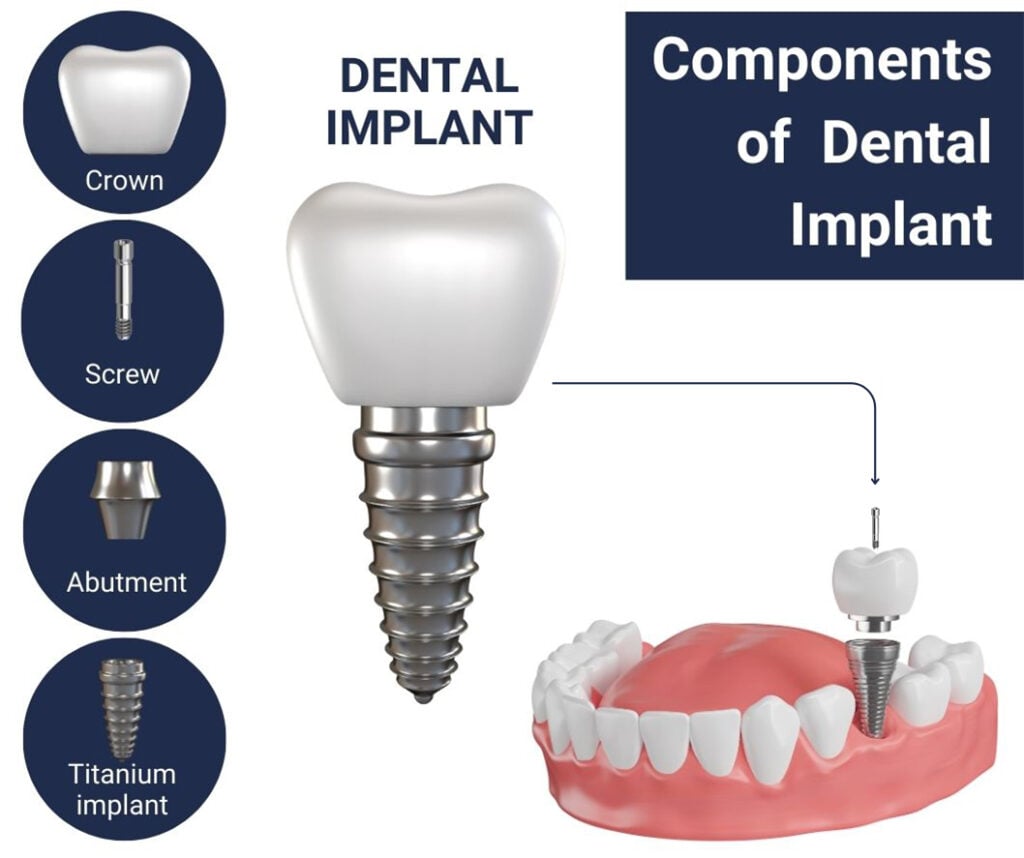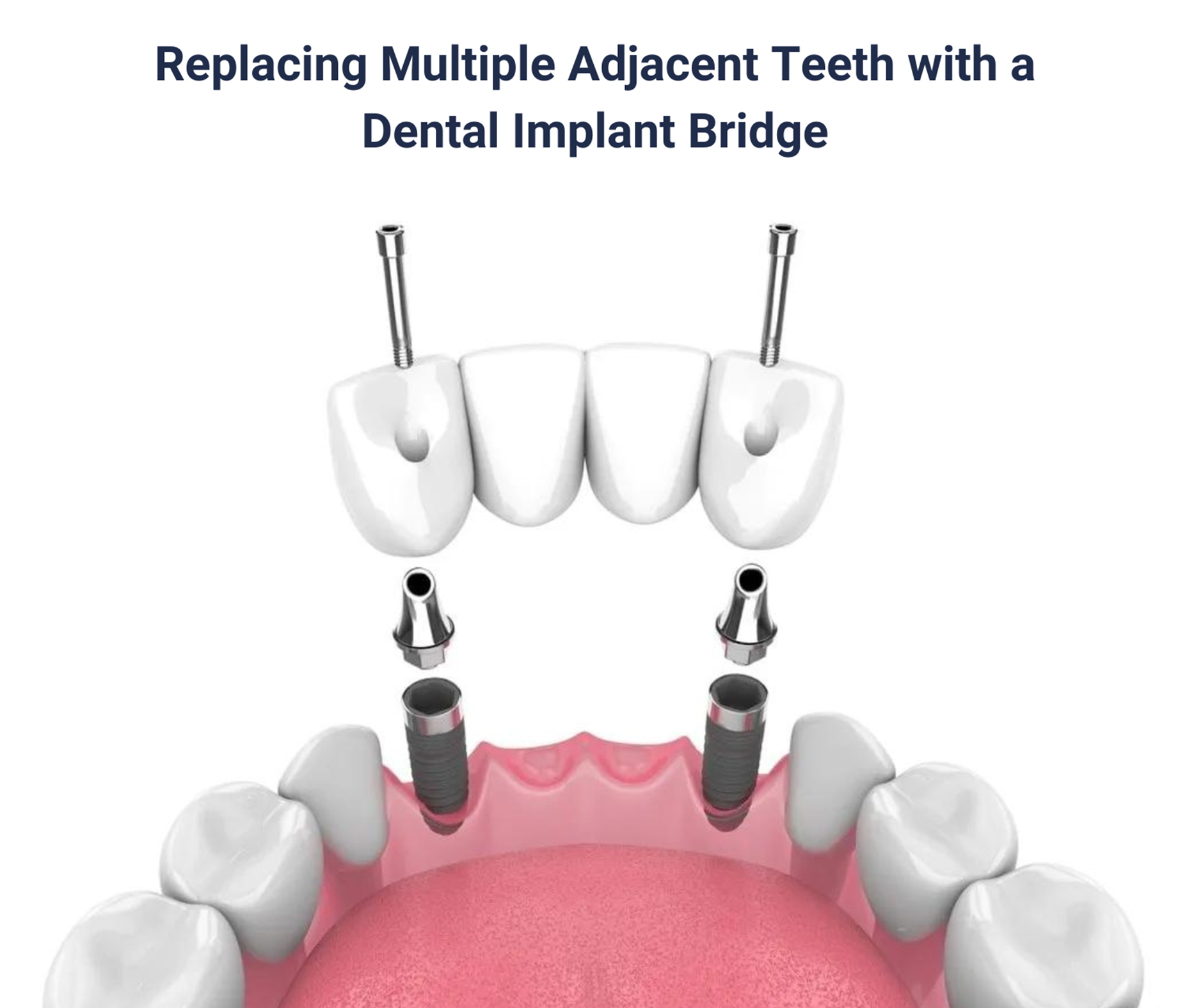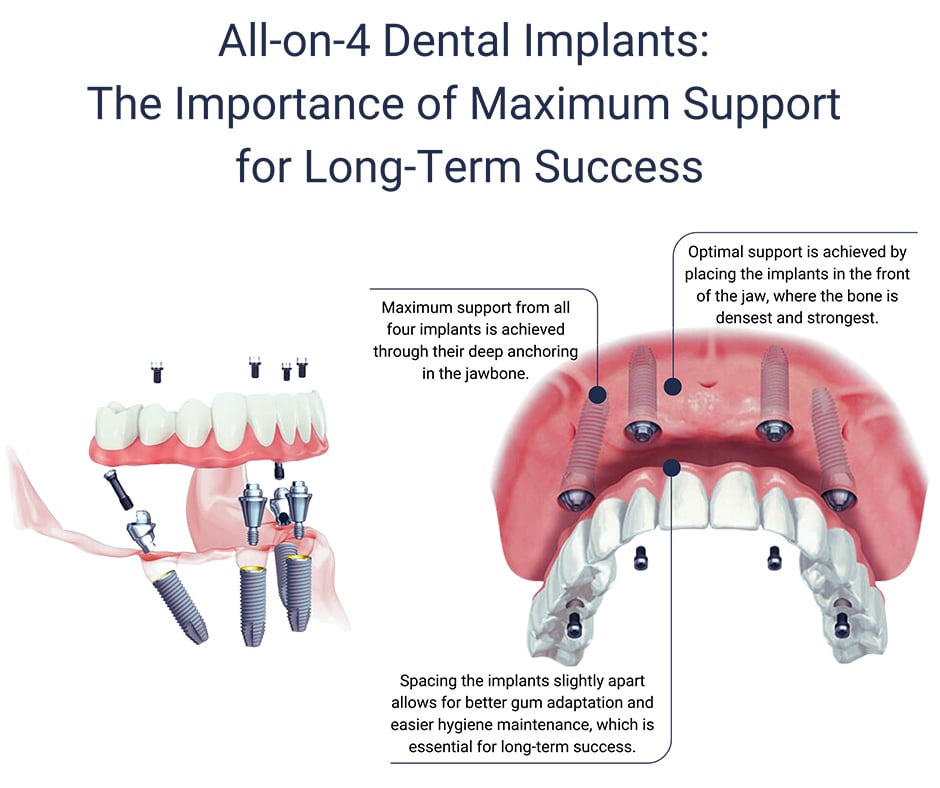Table of contents
Do you have a gap in your smile? Many people have lost one or more teeth or have teeth that are failing due to infection, decay, or trauma, and that must be extracted soon. Whatever the reason for your tooth loss, you will probably be interested in finding a permanent solution, which is where dental implants can help.
It is important to know what a dental implant is and how it works.
What is a Dental Implant?
 The simplest way to think of a dental implant is as an artificial tooth root. Losing a tooth means the entire tooth is extracted, including the tooth root that extends into the jawbone and which held the tooth firmly in place. A dental implant has a small screw or post, usually made from titanium alloy and which is inserted into the jawbone. Once the tooth is inside the jawbone, it soon fuses with the bone around it during Osseointegration. New bone cells grow on and around the implant screw, which is often specially treated or coated to encourage this process. A special attachment called an abutment is fitted onto the implant post, which protrudes above the gumline. The dental implant is now ready to have a new restoration. The result is a strong artificial tooth root that can support a new restoration.
The simplest way to think of a dental implant is as an artificial tooth root. Losing a tooth means the entire tooth is extracted, including the tooth root that extends into the jawbone and which held the tooth firmly in place. A dental implant has a small screw or post, usually made from titanium alloy and which is inserted into the jawbone. Once the tooth is inside the jawbone, it soon fuses with the bone around it during Osseointegration. New bone cells grow on and around the implant screw, which is often specially treated or coated to encourage this process. A special attachment called an abutment is fitted onto the implant post, which protrudes above the gumline. The dental implant is now ready to have a new restoration. The result is a strong artificial tooth root that can support a new restoration.
At the same time, this artificial tooth root helps protect the jawbone surrounding it. Every time you bite down on the implant restoration fitted onto the implant post, micro sensations are transmitted into the implant post and out into the surrounding bone, telling your body to renew old bone cells as they die. It closely replicates a real tooth root where the tooth root would transmit the sensations to the surrounding bone with a similar effect.
This protective effect on the jawbone is important because many problems associated with tooth loss arise because of jawbone resorption. For example, dentures become loose because the jawbone resorbs, reducing suction and retention for the denture, so it begins to move around easily and rub painfully on the gums. When one or more teeth are missing, the teeth adjacent to the space will begin to move toward this gap. These movements destabilize these teeth and create bite problems that can be difficult to correct later.
Dental implants are the only tooth restoration that helps prevent jawbone loss. This is one reason they are widely recognized as the gold standard for replacing missing teeth, providing a long-term solution. Dental implants have an extremely high success rate, typically around 95%. However, some of the more expert implant dentists, like periodontists, with specialized skills and training in this field can have success rates as high as 98%. With the right after-care, dental implants can even last for life.
Read more: How Painful is Dental Implant Surgery?
Now you know a bit more about dental implants, which type will be best for you? Three types are used in specific situations, which are listed below.
Replacing a Single Tooth
Frequently, dental implants are used to replace a single missing tooth, where just one implant post and implant crown are needed. It is an extremely effective technique; the surgery needed to insert the implant typically takes an hour or less to complete. Single tooth implants are a durable and natural-looking solution for replacing missing teeth. They also help to preserve jawbone health, which can prevent further tooth loss.

What to Expect If You Have a Single Implant?
You will need to meet with Dr. Rahmani for a thorough evaluation. He will determine if you are a good candidate for dental implant treatment and create a custom treatment plan for you. Once the treatment plan is complete, your implant surgery can be scheduled. Dr. Rahmani uses computer-guided technology to place the implant post, which ensures a precise and accurate placement. The process should be entirely painless, as Dr. Rahmani will use a local anesthetic to numb the area thoroughly before treatment begins.
After the implant post is in place, Dr. Rahmani will have a couple of options. He may choose to leave the implant post undisturbed, perhaps stitching up the gum over the implant posts and leaving it to heal and fuse with your jawbone. During this time, you can have a temporary restoration to fill in the gap. The temporary restoration might be a single-tooth bridge with wings that fit on the inner surfaces of the adjacent teeth, supporting the temporary tooth. This restoration is called a Maryland bridge. Otherwise, Dr. Rahmani may recommend using a dental flipper, a one-tooth denture that is cost-effective but only suitable for temporary restorations.
The second option is to fit an implant crown soon after surgery, attaching it to the new implant post. Usually, the implant crown is temporary and is made before surgery. It is specifically designed so you cannot bite or chew on the tooth so it will not contact the opposing teeth. Instead, it’s merely for cosmetic purposes but should look and feel pretty good until you can have the permanent implant crown once your dental implant has fused with your jawbone.
Once the implant post has healed, usually two or three months at least, the permanent abutment is attached to the implant post, and you can be fitted with your new implant tooth. A well-designed implant crown can look and feel exactly like a natural tooth.
A single tooth implant is a great option to restore one missing tooth, but it might not be the best or most cost-effective solution if you have several missing teeth adjacent to each other. In this case, a dental implant bridge can be a better choice. If you are considering single tooth implants, be sure to talk to Dr. Rahmani or your local dentist about the benefits and risks of this procedure.
Replacing Multiple Adjacent Teeth with a Dental Implant Bridge
When you have multiple teeth missing which were originally adjacent to each other, a dental bridge can be a better option than replacing each missing tooth with a single dental implant.
Instead, two or more dental implants can be inserted. These are covered with implant crowns attached to replacement teeth, forming an implant-supported bridge. The benefit of an implant-supported bridge is that treatment is more cost-effective. The replacement teeth can be securely held in place, and the implant posts help protect the bone around them, preventing resorption.
The replacement teeth between the implant crowns rest directly on the gum and are carefully designed to look lifelike and provide excellent functionality. It is also a good option where remaining natural teeth would not be strong enough to support a normal dental bridge, where crowns are fitted over the teeth adjacent to the gap, or where these teeth are missing entirely.
An implant-supported bridge provides good functionality and protects the remaining teeth by sharing the load created when you bite and chew food, preventing existing teeth from moving out of place. However, some bone resorption is likely because not every missing tooth is replaced with a dental implant.

What to Expect If You Have an Implant-Supported Bridge?
The process of planning and placing an implant-supported bridge is similar to placing a single dental implant. Once the dental implants are in your jawbone, Dr. Rahmani may choose to leave them undisturbed, and you will be supplied with a temporary restoration like an immediate denture. Otherwise, he might be able to fit a temporary implant bridge for use while the implants heal.
A temporary implant bridge can work well because it helps to splint the dental implants together. The whole reason for leaving implants undisturbed while they heal is to prevent any unwanted micro-movements. Using a temporary bridge to splint the implants together helps prevent this from happening. Then, once the implants have fused with your jawbone, the temporary bridge is replaced with your permanent bridge restoration.
If you are considering multiple tooth implants, schedule a consultation with Dr. Rahmani at the NYC Dental Implants Center. He will be happy to discuss your options with you and help you choose the best treatment plan for your needs.
Read more: Dental Bridge vs Implant
Replacing a Complete Arch of Teeth with a Dental Implant Bridge or Implant Denture
 If you are missing a complete arch of teeth, dental implants can be an excellent solution. There are two main options available:
If you are missing a complete arch of teeth, dental implants can be an excellent solution. There are two main options available:
Dental implant bridge: Multiple implants are inserted into your jawbone to support 10 or 12 teeth. The implants can be situated at regular intervals along the jawbone, or they can be inserted towards the front of the mouth, where the bone is naturally thicker and stronger. This technique can be extremely successful and more cost-effective, as it only requires a minimal number of implants. The implant bridge is then screwed onto the dental implants, where it remains in place permanently and can only be removed by your dentist.
Implant denture: Also called All-on-6 or All-on-4 dental implants are the most cost-effective solution because they only require a few dental implants. The dental implants have special abutments fitted onto them, allowing the implant denture to clip into place either directly onto the implants or onto a bar fitted onto the dental implants. Once the denture is clipped into place, it feels firm and secure, providing greater biting strength than an ordinary denture that merely rests on the gums. The denture is easy to unclip and remove whenever you want to clean it and for regular maintenance and to ensure you can clean around the dental implants thoroughly.
The techniques for planning and placing full arch implants are similar to those required for a single implant crown or an implant bridge for several teeth. Dr. Rahmani at the NYC Dental Implants Center is an expert in dental implants full mouth. He will work with you to create a custom treatment plan and help you choose the best treatment that meets your individual needs and budget.
Deciding if Dental Implants Are Right for You
Dental implant treatment is extremely versatile, and most people are suitable for treatment. When you first see Dr. Rahmani at the NYC Dental Implants Center, he will conduct a thorough examination of your mouth, discuss your dental and medical health, and conduct diagnostic tests to assess if you are suitable for dental implants and the type of treatment required.
Some people may require additional procedures like a gum or bone graft, especially those that lost teeth many years ago and have seen their jawbone significantly resorb. It’s rare for people to be unsuitable for dental implants, but this could be the case if you have certain conditions, such as uncontrolled diabetes or severe periodontal disease, or if you smoke heavily and are not prepared to quit.
Read more: Five Things to Know Before Getting Dental Implants
If you are considering dental implants, schedule a consultation with Dr. Rahmani at the NYC Dental Implants Center. He will help you achieve the best possible results. Using the highest quality components and having extensive experience, he is considered by many as among the best implant dentists in New York City.
Back to TopConsultation
